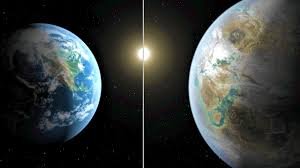"NASA Discovers Earth-Like Planet in Habitable Zone"

In a groundbreaking discovery, NASA scientists have identified an Earth-like planet located in the habitable zone of its star, potentially opening the door to the search for extraterrestrial life. The habitable zone, often referred to as the "Goldilocks zone," is the region around a star where conditions are just right—neither too hot nor too cold—for liquid water to exist on a planet’s surface. The discovery of this planet is a significant milestone in the ongoing quest to find planets capable of supporting life beyond Earth.
The planet, which has been dubbed by NASA as "Kepler-452b," was found using the space agency’s Kepler Space Telescope, a tool specifically designed to search for exoplanets. Kepler-452b is located about 1,400 light-years away in the constellation Cygnus. This discovery has sparked excitement within the scientific community due to its striking similarities to Earth. Kepler-452b has a similar size, orbit, and temperature, making it one of the most Earth-like planets discovered to date. It is roughly 60% larger than Earth and orbits its star, Kepler-452, once every 385 days, which is just a little longer than a year on Earth.
One of the most compelling aspects of this discovery is the fact that Kepler-452b lies within its star’s habitable zone, meaning it could potentially harbor liquid water, a key ingredient for life as we know it. Scientists believe that this planet might have conditions conducive to life, though more research is required to determine whether it has an atmosphere, oceans, or any other life-supporting characteristics. The discovery has prompted researchers to speculate about the possibility of microbial life existing on Kepler-452b, or even the future potential for human exploration.
Kepler-452b’s star, Kepler-452, is a G-type star, similar to our Sun, but slightly older. The planet’s proximity to this stable star means that it receives a similar amount of energy as Earth does from the Sun, further enhancing its potential to support life. Despite being located so far away, the planet’s discovery has profound implications for future missions to explore exoplanets, providing scientists with new targets for further study.
The find is a part of NASA’s broader mission to search for planets that could offer insight into the possibilities of life beyond our solar system. It is one of many planets discovered by the Kepler mission, which has significantly advanced our understanding of the universe. With more planets like Kepler-452b being discovered, the dream of finding a second Earth may not be so far-fetched after all. The search for extraterrestrial life continues, and this discovery could be a crucial step in unraveling the mysteries of the cosmos.